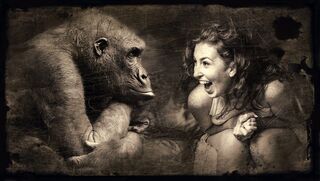Laughter
The 7 Real Reasons for Laughing
The psychology and philosophy of laughter.
Posted September 20, 2020 Reviewed by Jessica Schrader

Some philosophers thought highly of laughter. Others looked down upon it.
The circumstances in which we laugh are many and varied, but, deep down, we laugh for one (or sometimes several) of just seven reasons.
We laugh:
1. To feel better about ourselves. When looking for romance on dating sites and apps, we often ask for, or promise to offer, a good sense of humour (GSOH). Today, we tend to think of laughter as a good thing, but, historically, this has not always been the case. In particular, the Church looked upon laughter as a corrupting and subversive force, and for centuries, the monasteries forbade it. This notion that laughter can be less than virtuous finds an echo in the superiority theory of laughter, according to which laughter is a way of putting ourselves up by putting others down. The superiority theory is most closely linked with the philosopher Thomas Hobbes, who conceived of laughter as “a sudden glory arising from sudden conception of some eminency in ourselves, by comparison with the infirmity of others, or with our own formerly." Think of medieval mobs jeering at people in stocks, or, in our time, Candid Camera.
2. To relieve stress and anxiety. Clearly, the superiority theory is unable to account for all cases of laughter, such as laughter arising from relief, surprise, or joy. According to the relief theory of laughter, most often associated with Sigmund Freud, laughter represents a release of pent-up nervous energy. Like dreams, jokes are able to bypass our inner censor, enabling a repressed emotion such as xenophobia (or, at least, the nervous energy associated with the repression) to surface—explaining why, at times, we can be embarrassed by our own laughter. By the same token, a comedian might raise a laugh by conjuring some costly emotion, such as admiration or indignation, and then suddenly killing it. Although more flexible than the superiority theory, the relief theory is unable to account for all cases of laughter, and those who laugh hardest at offensive jokes are not generally the most repressed of people.
3. To keep it real. Much more popular today is the incongruity theory of laughter, associated with the likes of Immanuel Kant and Søren Kierkegaard, according to which the comedian raises a laugh, not by conjuring an emotion and then killing it, but by creating an expectation and then contradicting it. Building upon Aristotle, Kierkegaard highlighted that the violation of an expectation is the core not only of comedy but also of tragedy—the difference being that, in tragedy, the violation leads to significant pain or harm. Possibly, it is not the incongruity itself that we enjoy, but the light that it sheds, in particular, on the difference between what lies inside and outside our heads. The incongruity theory is arguably more basic than the relief and superiority theories. When someone laughs, our inclination is to search for an incongruity; and though we may laugh for superiority or relief, even then, it helps if we can pin our laughter on some real or imagined incongruity.
4. As a social service. According to the philosopher Henri Bergson, we tend to fall into patterns and habits, to rigidify, to lose ourselves to ourselves—and laughter is how we point this out to one another, how we up our game as a social collective. For example, we may laugh at one who falls into a hole through absentmindedness, or at one who constantly repeats the same gesture or phrase. Conversely, we may also laugh at, or from, an unusual or unexpected lack of rigidity, as, for instance, when we break a habit or have an original idea. Ultimately, says Bergson, we are laughable to the extent that we are a machine or an object, to the extent that we lack self-awareness, that we are invisible to ourselves while being visible to everyone else. Thus, the laughter of others usually draws attention to our unconscious processes, to our modes or patterns of self-deception, and to the gap, or gulf, between our fiction and the reality. This gap is narrowest in poets and artists, who have to transcend themselves if they are to be worthy of the name.
5. To put others at ease. Another way of understanding laughter is to look at it like a biologist or anthropologist might. Human infants are able to laugh long before they can speak. Laughter involves parts of the brain that are, in evolutionary terms, much older than the language centres, and that we share with other animals. Primates, in particular, produce laughing sounds when playfighting, play-chasing, or tickling one another. As with human children, it seems that their laughter functions as a signal that the danger is not for real—which may be why rictus characters such as Batman’s Joker, who send a misleading signal, are so unsettling.
6. For diplomacy. Most laughter, even today, is not directed at jokes, but at creating and maintaining social bonds. Humour is a social lubricant, a signal of contentedness, acceptance, and belonging. More than that, it is a way of communicating, of making a point emphatically, or conveying a sensitive message without incurring the usual social costs. At the same time, humour can also be a weapon, a sublimed form of aggression, serving, like the stag’s antlers, to pull rank or attract a mate. The subtlety and ambiguity involved is in itself a source of almost endless stimulation.
7. To transcend ourselves. Laughter may have begun as a signal of play, but it has, as we have seen, evolved a number of other functions. Zen masters teach that it is much easier to laugh at ourselves once we have transcended our ego. At the highest level, laughter is the sound of the shattering of the ego. It is a means of gaining (and revealing) perspective, of rising beyond ourselves and our little, limited lives, of achieving a kind of immortality, a kind of divinity. Upon awakening on her deathbed to see her entire family around her, Nancy Astor quipped, “Am I dying, or is this my birthday?”
Today, laughter is able to give us a little of what religion once did.
Neel Burton is author of Heaven and Hell: The Psychology of the Emotions and other books.


